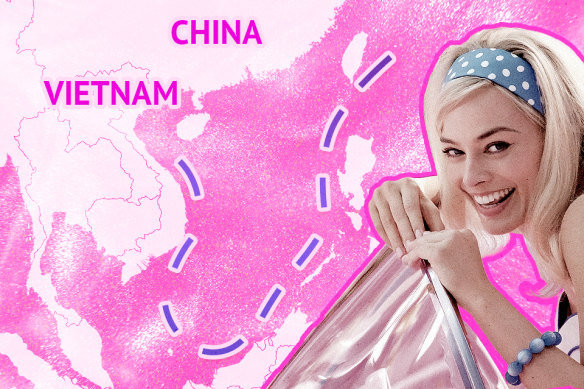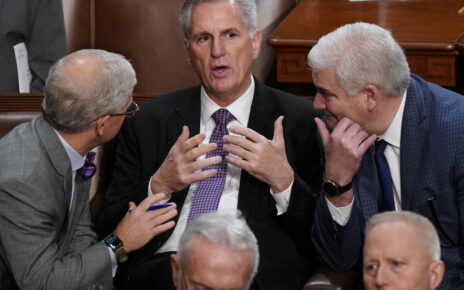Save articles for later
Add articles to your saved list and come back to them any time.
Singapore: If you look closely enough, you might just spot it. A dotted line between a yellow and blue blob, just above a yacht, hovering behind Margot Robbie as Barbie.
The map gives little away. Africa is barely recognisable. Asia is tipped on its side, with a second line emerging like a tail from somewhere that could be China but might not be.
Barbie has been banned by Vietnam over its depiction of the nine-dash line.Credit: Aresna Villanueva
A giant turtle covers some of South-East Asia. On Monday, Vietnam’s censors became so incensed by some doodles on the map that they banned the $150 million blockbuster.
The “nine-dash line” covers almost three million square kilometres of the South China Sea. It is an arbitrary claim for territory made by China over the world’s most contested maritime area that has been rejected by the United Nations.
The Chinese government uses it to justify harassment of foreign navy ships, claims to the Spratly Islands and the Scarborough Shoal, fishing and other resources in the world’s busiest shipping routes.
Most importantly, it provides a corridor for China’s growing submarine fleet, which in times of crisis would become vital to either attacking enemies or defending the homeland. US Indo-Pacific commander Admiral John Aquilino last year said Beijing had now fully militarised three islands within the disputed zone with few consequences.
“This is, in effect, the last line of defence for the Communist Party leadership, it carries major strategic importance,” said analysis by the International Institute for Strategic Studies, a London-based think tank.
“China’s behaviour in the South China Sea continues to damage relations with its maritime neighbours and with most members of the Association of South East Asian Nations, yet at the same time, China is suffering no real costs for it.”
The territorial claims have been disputed by Vietnam and the Philippines for decades. They argue it is a violation of their territorial sovereignty that subjects their islands and fishermen to campaigns of intimidation by the Chinese Coast Guard.
The head of Vietnam’s Department of Cinema, Vi Kien Thanh, on Monday decided the depiction of their superpower neighbour’s territorial claims in Barbie was a bridge too far.
The department banned DreamWorks animation Abominable in 2019 and Mark Wahlberg’s Unchartered last year for similar reasons. Australian spy drama Pine Gap also failed to make it through Vietnamese censors on the lookout for cartographical infractions.
“We do not grant a licence for the American movie Barbie to be released in Vietnam because it contains the offending image of the nine-dash line,” said Thanh.
Thanh did not specify which dotted lines had offended Vietnam’s censors. One U-shaped line has nine dashes and the appearance of China’s maritime claim but looks to be somewhere between North America and Greenland. The second line whips out from Asia but has only eight dashes and lacks Chinese characteristics.
But now that China’s Ministry of Foreign Affairs has seized on the opportunity – the accuracy of the map matters little. Barbie has entered the realm of geopolitical disputes, where symbolism can be important as reality.
“China’s position on the South China Sea issue is clear and consistent,” spokeswoman Mao Ning said on Tuesday. “The relevant country should not link the South China Sea issue with normal cultural exchange.”
The outcry has been met with silence from its producers. In blunt economic terms, Warner Bros has made an assessment that any retreat is likely to be met with backlash from Chinese consumers who are suddenly enamoured with the blonde American icon from Willows, Wisconsin.
“I initially had no interest in the film, but now I must see it,” said one patriotic filmgoer on the Chinese social media site Weibo. Another thanked Warner Bros for “picking the right side on an important matter”.
The China Project reported that one fan was more blunt. “Barbie knows which film market is bigger.”
The Vietnamese film industry is booming, but it is worth a fraction of the $2 billion a month taken from the box office in China in a sector dominated by the local industry. The Chinese market has been boosted by heavy censorship and competitive restrictions on foreign films.
Each year the China Film Administration only allows 34 foreign films to be shown in its theatres, creating a windfall for films that make it through and millions of dollars in missed earnings for those that do not.
There lies the dilemma for Hollywood and its forays into the huge Chinese market.
Like its actions in the South China Sea, Beijing knows it can mostly get away with it.
Get a note directly from our foreign correspondents on what’s making headlines around the world. Sign up for the weekly What in the World newsletter here.
Most Viewed in World
From our partners
Source: Read Full Article



